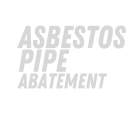The standard procedure for testing asbestos on pipe coating is a simple procedure for pipeline salvage and recovery companies. There are many labs for testing and currently Pipeline Equities uses J-3 Resources, Inc. of Houston for most asbestos testing procedures.
J-3 tests more than fifty samples of pipe coating per month at their Houston lab. Their clients generally are consultants and environmental companies working on behalf of pipeline companies and other contractors. Overwhelmingly, they consist of a tar/felt mixture of some variation. This could be layers of tar-felt-tar, a layer of tar and felt, or a combination that mixes the felt in with the tar. Generally, the asbestos in the coating will always come from the felt wrap or paper rather than the asbestos being mixed into the tar, unless a heavy concentration of asbestos in the felt wrap migrates to the tar during manufacture of application.
When determining the overall content of asbestos in the material or coating involved, only the felt would be tested as very seldom is the asbestos part of the tar coating. For example, the felt wrap might contain fifty per cent asbestos while the tar layer has none. In this case the overall coating would have possibly a fifteen percent asbestos content by volume depending on the thickness of the tar portion of the coating.
Sometimes the content of asbestos is reported separately with the analysis showing forty percent asbestos in the felt and zero content in the tar portion.
Not all coating contains asbestos. In this case, the report from the lab would should no asbestos present. (See Crane 8″ and 10″ in exhibit section). Samples were taken of coatings on two pipelines at a random point. Other samples will be taken at different junctures as the job progresses. On a pipeline, the coating may vary from one location to another reflecting different materials used at different times and different circumstances. A prudent and knowledgable recovery or salvage operator will check the pipeline coatings he is dealing with periodically along the line testing for asbestos content every ten to twenty thousand feet. He will be careful to take samples on the body proper of the pipe and not at an angle, weld, or connection where the angle or joint of pipe is joined together. Many times these sections could have a different material or is a “patching” type substance which probably would not have Asbestos Containing Materials. A good operator knows this and would avoid sampling in these areas.
- J-3 has three methods for testing for asbestos in materials:
- TEM or Transmission Electron Microscopy.
- PLM or Polarized Light Microscopy.
- PCM or Phase Contrast Microscopy.
The Polarized Light Microscopy or PLM is the method most used in chrysotile asbestos testing in pipeline coatings.
The Exhibit of Section E contains an actual test report taken by J-3 Labs regarding a current job in Crane, Texas. This report shows no asbestos present. The accompanying “chain of custody” report tracks the sample.
The Exhibit of Section F shows the results of testing on the Slaughter project indicating 25% Chrysotile asbestos content in the coating material along with the date and tracking information.














